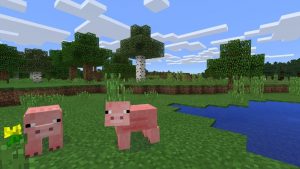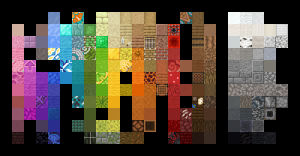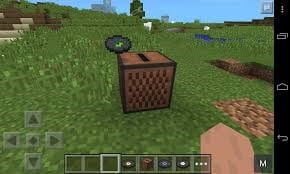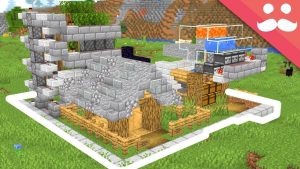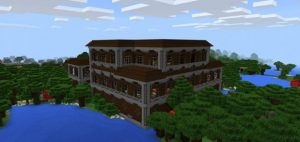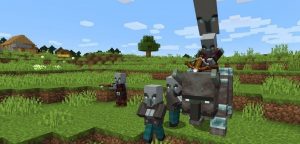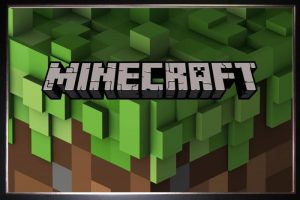 Minecraft is an open world sandbox game released in alpha on July 2nd 2010, in beta on December 20th 2010 and fully released on November 18th 2011. Minecraft was originally developed by Jens Bergensten (Jeb) and Markus Persson (notch). It was sold to Mojang and subsequently Microsoft on September 15th 2014. Minecraft is available in two main variants, Java edition on PC and Bedrock edition on mobile, console and PC. These two systems do have some major differences, especially in their Redstone (electronics) and combat mechanics, with Java favouring precision and reliability instead of intuitiveness and Bedrock favouring ease of use and making the game more accessible for beginners and younger users.
Minecraft is an open world sandbox game released in alpha on July 2nd 2010, in beta on December 20th 2010 and fully released on November 18th 2011. Minecraft was originally developed by Jens Bergensten (Jeb) and Markus Persson (notch). It was sold to Mojang and subsequently Microsoft on September 15th 2014. Minecraft is available in two main variants, Java edition on PC and Bedrock edition on mobile, console and PC. These two systems do have some major differences, especially in their Redstone (electronics) and combat mechanics, with Java favouring precision and reliability instead of intuitiveness and Bedrock favouring ease of use and making the game more accessible for beginners and younger users.
Minecraft has three main game-modes, all with a different focus; hardcore, a solely survival based gameplay, creative, where the player is invincible and free to construct or destroy whatever they please and finally survival, a blend of these two with some of the freedoms of creative and some of the challenge of hardcore. For this review I will be using the Java and Bedrock editions interchangeably and more specifically their shared 1.14 Village and Pillage update in the original survival mode.
Control and game play
When a new world is created, the player spawns in one of 60 procedurally generated unique biomes with no instructions except an insignificant achievements (EXP) menu. The player is given only a health bar, and experience bar, and a hunger bar to guide them. The entire world is comprised of blocks that, aside from a few blocks, are destructible, giving the player resources when destroyed. These resources can be crafted using the in-game crafting mechanic into all manner of things ranging from essential like tools and armour to purely aesthetic blocks like paintings or dyed wool. The world can be manipulated to satisfy these bars, with farms being created to grow food and a house being built to protect the player and their valuables from mobs (enemies). Mobs, although technically meaning any non-player entity, generally refers to the constantly spawning aggressive mobs that attack the player through a variety of means such as bows, tridents, grapples and explosions. Friendly mobs are referred to as passive mobs. Mobs primarily spawn at night and are supposed to be the driving force of progress in the early game. The player is challenged and forced to make better weapons, armour and bases. As the game progresses, the player is free to discover their own victory condition, which in such a diverse game can vary wildly. Even the goal Minecraft provides, (killing the ender dragon) is superseded as the player is allowed to continue long after the beasts demise.
Graphics
Minecraft uses a minimalist cube-based graphics system featuring arrangements of geometric 1mx1mx1m blocks that act as the building blocks of the world. These blocks feature a simplistic smooth texture making use of a largely pastel pallet. This choice of using blocks rather than smoother terrain features was revolutionary for its time when most other game developer was persuing realistic graphics. This low poly system makes it easy for the player to place any block anywhere creating any world they desire.
Sound
One of Minecraft’s most distinctive features is its unique audio design. It combines rhythmic repetitions of real-world sound when the player does a task paired with a calm relaxing soundtrack that is played in the background. This pairing induces a trancelike state in which many hours can seem to slip away, this and has contributed to the game’s cult following. Minecraft does technically have a changeable soundtrack through the use of the jukebox. The jukebox plays rare music discs that the player finds, although it has such a short range and playtime that it is not really feasible. This is not a catastrophic issue as the default soundtrack is such a fitting selection of songs.
Fun factor
Minecraft is a fun game which is reflected in its sales figures of 176 million copies sold. It is unique in requiring its players to interact with other players to figure out how to do certain things such as building a Nether portal and find the end, which encouraged multiplayer play and created a vibrant community. By having no clear goals, the game creates many different ways to enjoy the game, whether it be building a huge base, a Redstone contraption, an automatic farm, a minigame to play with your friends, or even fighting a boss like the Wither or Ender Dragon.
Replayability
Minecraft has had trouble including more things for the player to do since its release. In the past, after one play through there was very little new content to explore, aside from building more and more farms and bases. Almost every aspect of the game has gained a cult status and is seen in a nostalgic viewpoint from the audience. Therefore, any new update cannot change or reimagine aspects of the game, it can only add new things that do not change the core gameplay. Mojang has tried to increase the games replayability by including more generated structures like the woodland mansions, ocean temples and ocean monuments. The issue they have had is adding incentive to explore the new areas. The solution they have found is adding ores and precious materials to chests in the structures. This neither provides significant incentive to explore these new structures nor maintains the scarcity of resources Minecraft needs to be challenging. This discovery for the sake of discovery is short-sighted and makes Minecraft more of conquest game like Terraria rather than the survival game it was originally known and loved for.
Conclusion and opinion
I have found Minecraft to be a fun game to both play and watch on streaming services. Minecraft has a very positive community due to its required player interactivity. The newest update, Village and Pillage, is a step in the right direction in adding new challenges that drive progression rather than pointless features. I think that Minecraft is a beautiful game that I would suggest it to anyone for its gameplay value and its historical significance in the open world sandbox genre.
